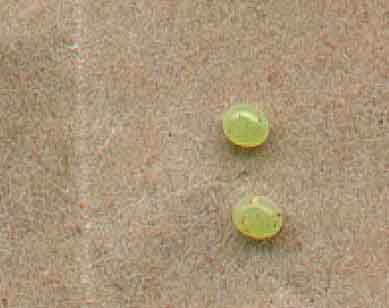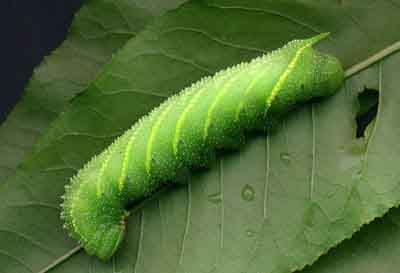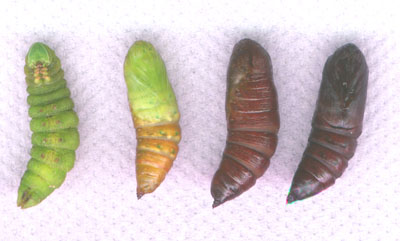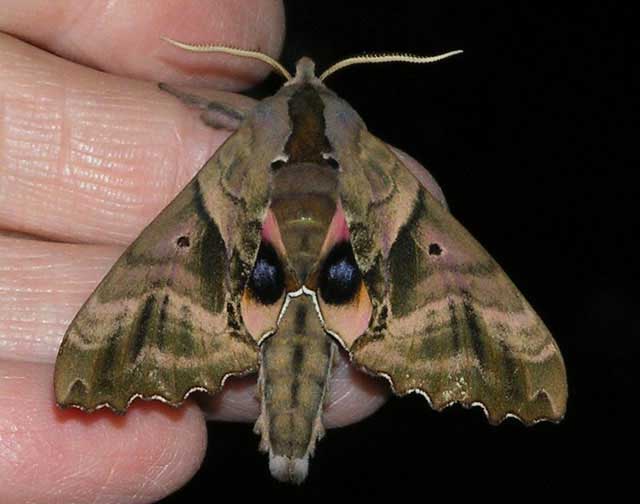ECLOSION:Little is known about the eclosions of the
earth pupators. Many believe the moths wiggle their way to the
surface from subterranean chambers just prior to eclosions.
The moths need to climb, hang and inflate their wings.
This ventral image, courtesy of Tim Dyson, Peterborough, Ontario,
July 25, 2006, shows
a male (verso) at rest with the hindwing lobes projecting above the
forewing costa.
| 
|
Here on
Prince Edward Island, my reared Paonias excaecata pupae emerge right around midnight.
I have observed the same eclosion time for Smerinthus cerisyi.

SCENTING AND MATING
Males of the eye-spotted sphinxes
rest with the posterior of the abdomen curved upwards. This species
mates readily in small cages and females will call and mate shortly
after inflating wings.
EGGS, LARVAE, PUPAE:
Females as well as
males of this short-tongued (3.4 mm) species come in to lights and
females readily deposit green, spheroid eggs (100+) in paper bags
without feeding. Excaecata eggs are slightly larger than poecilus and
tend to be more toward a yellow-green.
Incubation lasts approximately 8 days at room temperature. These Blinded Sphinx eggs are from a female
taken on June 3, 1999, in Montague, Prince Edward Island. | 
|

Paonias excaecata hatchling, Wolf Creek, Josephine County, Oregon,
August 2011, courtesy of Edna Woodward.

Paonias excaecata second instar, Wolf Creek, Josephine County, Oregon,
August 2011, courtesy of Edna Woodward.
Edna found a tiny larva on apple foliage in Wolf Creek, Josephine County, Oregon in 2008. She reared it through and obtained an adult moth in June of 2009.
She remembered the characteristic long, rust-coloured anal horn with an offwhite interruption near its center, evident in the image above image from a female taken
in July 29, 2011.
Larvae accept willows, birches, and cherries.
I have tried all three and my larvae progressed most rapidly and
grew the largest on pin cherry (Prunus pensylvanica). I have
found large larvae, however, in the wild on
oak and poplar.The hornworm to the right (2.5 x life size, July 11, ex egg above) will grow another half inch and fatten
considerably on many pin cherry leaves in the next 3-5 days before descending the branch to seek
out a suitable pupation area. |  Scan by Bill Oehlke |

Paonias excaecata, Medford, Taylor County, Wisconsin,
found on cherry, August 2, 2008, courtesy of Joan F. Rickert.

Paonias excaecata fifth instar on scrub oak, September 24, 2008,
Walpole, Norfolk County, Massachusetts, courtesy/copyright Sam Jaffe.
Paonias excaecata larvae pupate readily in 4-5 days
under artificial conditions, i.e., a dark enclosure with loose paper
litter. I use a covered, five-gallon bucket loosely lined on the bottom with three to
four sheets of paper towels. When larvae are about ready to pupate, i.e., they have
left foliage to descend tree branches or stems, I gently put them in the buckets. I
put as many as twenty larvae in a single pupation bucket.
Blinded sphinx pupae are smooth and shiny and
a very dark chestnut colour, once they have hardened. Initially they are very soft and green.
They should not be moved for a week or so to give the pupal shell time to harden.Larvae develop very stumpy legs and
a reduced body size as a result of clearing the intestinal tract just prior to pupation.
|  |
Visit
Paonias excaecata, Bradford County, Florida,
courtesy of Edith Smith.
Visit Paonias excaecata,
Montgomery County, Texas, May 26, 2008, Tristyn Schreiber Underwood.
Visit Paonias excaecata adult, from larva found on apple, Oregon,
June 29, 2009; wild female July 29, 2011, Wolf Creek, Josephine County, Oregon, courtesy of Edna Woodward.
Visit Paonias excaecata, MV light on small building on County Hwy R18, Boone County, Iowa,
June 23, 2009, Thomas Jantscher.
Visit Paonias excaecata, Canton, Norfolk County, Massachusetts, July 31, 2009, courtesy of
Kerri Walonoski.
Visit Paonias excaecata female, Eddie Jones Park, Shreveport, Louisiana, April 15, 2013, Jeff Trahan.
Return to U. S. A. Table
Return to Main Sphingidae Index
Return to Smerinthini Tribe












